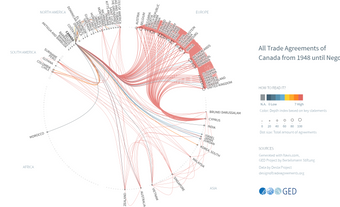
Mackenzie's Low Tariffs
Tariff protection for manufacturers was the rallying cry of Macdonald's Liberal-Conservative coalition in its successful 1878 general election campaign.
Prime Minister Alexander Mackenzie's Liberals, in office from 1873-78, had previously adhered to a policy of tariffs strictly for revenue purposes — around 20 per cent of customs duties on manufactured goods. They'd remained faithful to this non-protectionist policy, despite the economic depression of the 1870s and the failure of the Liberals' 1874-75 attempt to negotiate a reciprocity or free trade agreement with the United States.
Macdonald's National Policy became a public issue after the Liberal government failed to raise the tariff in the 1876 budget. After Macdonald came to power again in 1878, a higher tariff was announced in the budget of 14 March 1879, following consultation with business interests.
Tory Economic Strategy
High tariffs were intended to broaden the base of the Canadian economy and restore the confidence of Canadians in the development of their country. Macdonald acknowledged that his National Policy would also assist a group of wealthy businessmen, including several in Montreal, who in turn could be counted on to contribute generously to the Conservative Party.
The tariff on most foreign manufactured goods was increased, affording substantial protection to Canadian manufacturers. Equally important to manufacturers were the reduced customs duties on imported raw materials and semi-processed products, which lowered their costs of production.
Over time the National Policy took on a broader meaning in Conservative Party rhetoric, which tended to equate the Policy with its larger development strategies: the Canadian Pacific Railway (1880s); western settlement, including the Dominon Lands Act of 1872 and immigration policy; harbour development; and the subsidization of fast steamship service to Europe and Asia to facilitate the export of Canadian products. The Policy, and its many parts, became the centrepiece of Conservative Party policy for decades, even being espoused by Prime Minister R.B. Bennett in the 1930s as fervently as it was by Macdonald in the 1880s.
Macdonald's last election, in 1891, was fought successfully in defence of his National Policy and against the opposition Liberal call for commercial union and "unrestricted reciprocity" with the United States.
Ongoing Election Issue
When Prime Minister Wilfrid Laurier eventually brought the Liberals to power in 1896, his government adopted the same protectionist principles — if not the rhetoric — of the National Policy tariff, and kept its general tariff at similarly high protectionist rates.
Even the Laurier government's famous reciprocity agreement with the US in 1911 made only a few concessions on import duties on manufactured goods; the bulk of the agreement abolished duties on natural products, and customs duties were lowered on only a restricted list of manufactured goods. But this alarmed manufacturers enough to swing their support back to the Conservatives in the 1911 general election.
Campaigning on the argument that a mature economy had developed under the National Policy, that reciprocity threatened the Canadian economy, and that the choice before the electors was "whether the spirit of Canadianism or of Continentalism shall prevail on the northern half of this continent," Robert Borden's Conservatives swept to victory, bringing a continuance of the National Policy.
Slow Dismantlement
While the National Policy was a political success in central Canada, it was extremely unpopular in the West and was at the core of lingering resentment toward the
eastern manufacturing base.
The National Policy was slowly dismantled during the extended tenure of the Liberal Party under Prime Ministers William Lyon Mackenzie King and Louis St. Laurent in the 1940s and 1950s respectively. The Canadian and American economies gradually integrated after the Second World War. With the signing of the Canada-U.S. Autopact in 1965 the two countries reached a major milestone in economic integration that would continue. In 1989, Canada and the US signed the Free Trade Agreement (See: Free Trade), further cementing economic ties.

 Share on Facebook
Share on Facebook Share on X
Share on X Share by Email
Share by Email Share on Google Classroom
Share on Google Classroom


_IMO_9785756,_Maasmond_pic.jpg)
